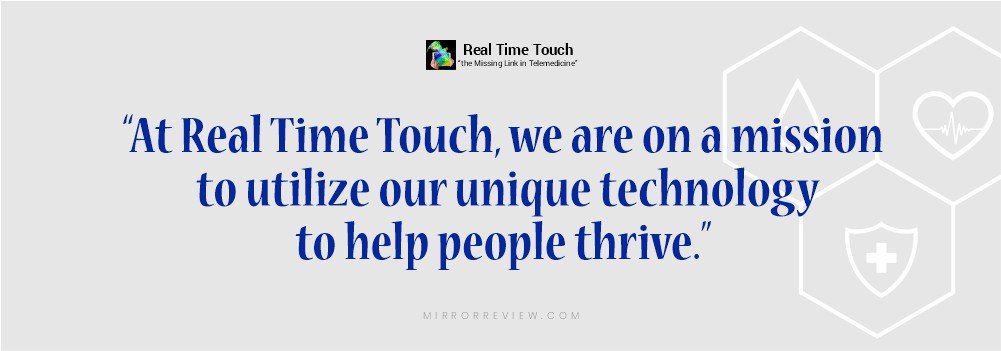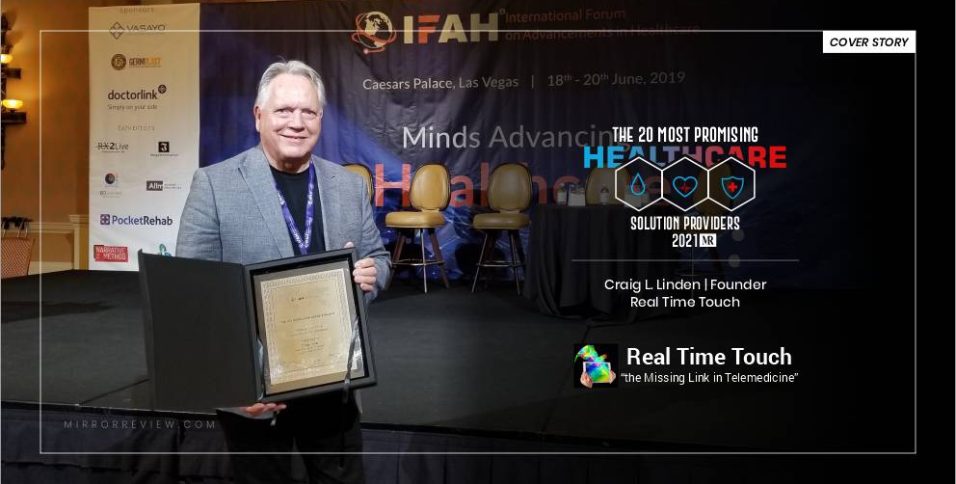In today’s connected world, the role of technology has become more important in the healthcare industry. Over the years, different verticals of the healthcare industry have adopted technology and witnessed the benefits associated with it. Telemedicine or telehealth is one such aspect of technology that has the potential to revolutionize healthcare with its immense potential. The onset of the COVID-19 pandemic last year has further propelled the demand for these technologies.
While several new players are emerging withintelemedicine and telehealth, a little known veteran startup, Real Time Touch , has managed to survive in the ever-changing and competitive healthcare landscape. The San Diego based company was established in 1999, motivated by founder, Craig L. Linden’s dream of seeing advanced physically augmentedtelemedicine remotely treat people around the world. The company was born with a vision to aid people with advanced wireless communication and remotely guided medical devices for better healthcare and education.
The Inception of Real Time Touch
One night in 1997, Craig experienced symptoms of a TIA-like stroke and during recovery, he had several inspirations regarding rehabilitation and remote medical treatment. Using a long air tube, he experimented to connect two blood-pressure hand air bulbs. He put one bulb in each hand and used the connected bulb as a cross-body and cross-brain exerciser as he pumped the bulbs back-and-forth from hand to hand. Later, he added music and used 4 bulbs to connect his feet for pumping as well. He realized this simple technology could be modified with electronics and wireless RF and used to provide telehealth treatment—and Real Time Touch was born.
Comprehensive Telemedicine System
Real Time Touch’s patented telemedicine platform offers a future for a unique comprehensive telemedicine system which may include—doctor-patient video conferencing, remote patient monitoring, doctor and AI diagnostics, prescriptions, medication control, and remotely guided medical and therapy devices. The company has a granted patent that has the potential to transform telehealth and telemedicine. Linden’s patent for “Powered Physical Displays on Mobile Devices” was granted by the USPTO in 2017.
Additionally, Real Time Touch offers unique value to help solve the medication adherence problem. The company is seeking international partners to help achieve liftoff for its revolutionary telemedicine vision which is comprised of a Remote Rx Dispenser (prototype hardware) and patented Telemedicine Platform, alongside the USPTO-granted patent. The remote dispenser addresses medication adherence problems, while the telemedicine platform integrates multiple eHealth services. Real Time Touch is represented by four patent and intellectual property law firms located in the United States, Canada, and India.
A Team Led by Visionaries
Real Time Touch’s team, led by versatile leaders such as Craig Linden and Chris St. John has been an integral part of the company’s growth over the years. Linden performs multiple duties from inventor, prototype builder, CEO, and handles various operations from management to business operations. He has been working tirelessly to improve future health outcomes via technical innovations in Rx, wearables, video, AR/VR, and physically augmented telemedicine visits.
St. John, on the other hand, is a technology and business development technologist and entrepreneur. He has over 20 years of experience in technology and startup development, and UI/UX high volume data apps, APIs, Cloud, and marketing. These veterans are leveraging their extensive experience to drive the company towards unrivaled growth.
Upsurge in Demand
When Real Time Touch was created, Craig had envisioned advanced remotely controlled home devices for medical treatments and vital sign monitoring. Doctors and nurses would control and guide home-based and wearable monitoring, treatment and therapy devices for pain management, medication release, magnetic, electronic, and physical rehabilitation.
However, advanced smartphones and connected tablets didn’t exist at that time. Moreover, the wireless communication networks were slow and could not handle the required data for real-time live video. Thus, Craig applied for international patents for his advanced platform and technologies. There was little interest for his video-connected mobile devices and advanced smartphones with multiple cameras until the COVID-19 pandemic struck.
Before the onset of the pandemic telemedicine and telehealth were thought by most to be a convenience. As the crisis expanded its footprint, virtual telehealth visits became a necessary and better alternative to in-person doctor visits. These visits helped relive the healthcare system by tele-treating people with non-life-threatening health issues in their homes.
Different People, Different Response
Linden has divided the people he has spoken to about the pandemic into three groups. Some people trust science, practice the preventive measures, and get vaccinated. Secondly, some people distrust science, believe the vaccine was developed too quickly, and don’t get vaccinated. Lastly, there are people who have suffered from the pandemic, alongside those who have lost a friend or a loved one. “These people wish they had trusted science and better protected themselves and their families,” asserts Linden. Linden hopes Real Time Touch’s platform and injection devices will soon enable remote caregiver guided vaccinations that will more quickly reach people everywhere.
Preparations for the Future
Real Time Touch is seeking to develop relationships with a variety of key individuals and companies in the medical device, software, and eHealth sector. By building healthcare industry partnerships, along with obtaining necessary FDA approvals, the company is focused on accelerating its success in the near future. Upon funding and completing its team, Real Time Touch plans to introduce a variety of new remote-controlled home-based treatment, monitoring, and therapy devices.
The company has planned devices such as ePlexor™ for aiding in remote, video-connected neurological exams. Its individual medication dispensers help for controlled decentralized clinical trials, remotely operated controlled-substance release devices, and remote Rx control for independent seniors—as well as help recently released hospital patients who need help adhering to their medication regimes. In the upcoming years, Real Time Touch plans to launch home-based remote caregiver controlled magnetic and laser treatment devices, remotely controlled injection and infusion devices, and remotely guided sonograms. Linden believes that there are few technical limits to the types of medical devices that can be adopted for home use when combined with professional control and secure communication networks. He maintains that technological advancements such as 5G, AI, universal internet, and the digitization of healthcare are leveraging a promising future of affordable healthcare that will wirelessly reach everyone.

Read Full Magazine: The 20 Most Promising Healthcare Solution Providers, 2021





